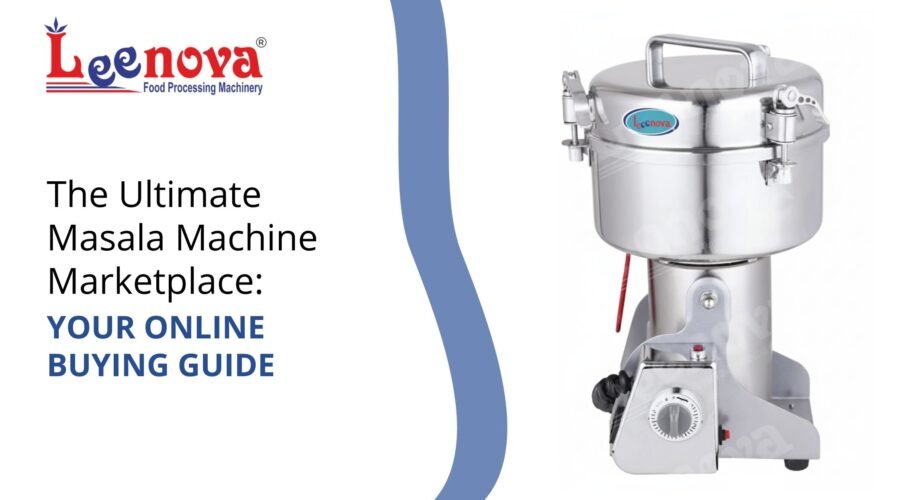Every spice tells on your process. If your chilli runs hot from friction, your colour drops. If your coriander comes out uneven, your marinade won’t bind. And if your grinder turns temperamental at 6:30 p.m., your team loses faith faster than you can say “extra tadka.” This guide is written to help kitchens, kirana grinders, cloud kitchens and small processors buy once and grind right—by decoding the real-world patterns you’ll actually meet when shopping online for a commercial masala machine.
About Leenova: Leenova Kitchen Equipment designs and manufactures commercial masala machines, pulverisers, flour mills and allied prep equipment—hygiene-first builds, repeatable throughput, and service you can reach.
Snapshot: What a “Masala Machine” Really Is
In marketplace speak, a masala machine is a dry spice grinder/pulveriser engineered for turmeric, chilli, coriander, cumin, pepper and dry herbs. Think of it as a compact production unit: motor + chamber geometry + mesh control = the flavour profile you sell. Buyers typically sit in three bands:
- Home-business upgraders & test kitchens: light duty, tight spaces, frequent changeovers.
- Restaurants & cloud kitchens: predictable fineness, low housekeeping burden.
- Kirana grinders & small processors: uptime, dust discipline, and cost per kilo.
Two truths to carry forward: published kg/hr is a range, not a promise; and mesh + moisture + feed discipline decide your day.
Price & Purchase at a Glance
Top marketplace pages rarely pin a single price; they offer an indicative band and a clear Get Best Quote / Add to Enquiry / Request Callback / WhatsApp CTA. Expect “taxes, shipping, installation extra.” What nudges the final number? HP, cyclone option, chamber size, MS vs SS build, sieve kit, and local logistics. Your best value isn’t the lowest sticker—it’s transparent specs, responsive support, and spares that ship before your next batch.
Types & Variants (How Choices Are Framed Online)
- Single-chamber vs Double-chamber: Single keeps footprint and complexity low; double can tighten uniformity for stricter texture targets.
- Cyclone vs Non-cyclone: Cyclone improves dust capture and yield; non-cyclone keeps things lean where space and budget rule.
- 2-in-1 (Flour + Masala): Useful for mixed menus—if you commit to a cleaning SOP between categories.
- Kandap/Hammer-type: A traditional impact style some prefer for specific spices.
- MS vs SS Builds: Powder-coated MS for rugged value; SS for audit-friendly wipe-downs and high humidity zones.
- Mobility & Noise: Casters for the Lego kitchen; optional acoustic measures for sanity.
Key Highlights You’ll See Everywhere
- Quick sieve swaps for fast fineness changes.
- Compact footprint for realistic prep rooms.
- Cyclone/collector options to keep air and surfaces clean.
- Balanced rotor, less vibration, and sensible access panels.
- Electrical protection (MCB/overload) and stabiliser guidance for moody mains.
- Energy framing: move beyond “units/hour” to kWh per 100 kg—a fair metric that bakes productivity into consumption.
Reading the Spec Table Like a Pro
Motor/HP | Phase/RPM/Voltage | Capacity (kg/hr) | Chamber/Cutter/Liner | Build (MS/SS) | Power Use
- HP doesn’t act alone. Chamber volume, liner geometry and RPM shape real output.
- Capacity is contextual. The same machine will do more on medium coriander than on ultra-fine haldi.
- Power use matters in context. Normalise to kWh/100 kg to compare apples to apples across vendors.
Applications (and Honest Caveats)
A credible unit handles turmeric, chilli, coriander, cumin, pepper, dry herbs—and, model-dependent, sugar/salt. Oily seeds and ultra-fine meshes reduce throughput and raise heat; moisture in feedstock punishes consistency. If allergens or gluten are a factor, put cross-contamination rules in writing and follow them—your reviews (and conscience) will thank you.
Power & Electricals: The Unsexy Deal-Breaker
Single-phase can work at lower HP and lighter windows; long, demanding shifts behave better on three-phase. Size your cable gauge correctly, fit MCB/overload, and add a stabiliser/AVR if your grid throws tantrums. Place the machine with airflow in mind; warm flour and spicy oil vapours are early warnings you should not ignore.
Build & Hygiene: Designed for Real People, Not Brochures
Good machines clean fast. Look for tool-less access to chamber and discharge, no dead zones for residue, balanced rotors for operator comfort and bearing life, cyclone discipline for dust and yield, and food-contact finishes that actually wipe clean. Your clean-down KPI is simple: minutes from shutdown to ready-again.
Capacity in the Real World (Claims vs Shift Math)
Use a planner that never lies:
- Daily kg target ÷ milling hours = target kg/hr.
- Add 20–30% headroom for sieve swaps, cleaning, and the many tiny surprises of hospitality.
- Size for peak days, not sleepy Tuesdays. The “cheapest” machine that overheats and forces rework is the costliest decision you’ll make.
Buying Checklist (Save This)
- Capacity with headroom for peak days.
- HP/Phase fit that matches your duty cycle; three-phase when consistency matters.
- Fineness control—mesh range you’ll actually use and how quickly you can swap.
- Thermal behaviour—cooler grind protects colour, aroma and shelf life.
- Noise & vibration—operators and bearings are both finite resources.
- Dust control—cyclone/collector or disciplined housekeeping (ideally both).
- Mobility/footprint—does it fit your choreography?
- Spares & service—keep a hot-spares kit; confirm lead times in writing.
- Warranty & SLA—response time beats duration.
- Demo/POC—test with your spices and meshes, not showroom wheat.
Where to Buy Online (Your Map)
- Direct brand/manufacturer stores: clean lineage and warranty clarity.
- Authorised dealers: local install/training and spares nearby.
- Multi-seller marketplaces: broad options and reviews—verify spec authenticity to avoid look-alikes.
Green flags: transparent spec tables, mesh details, clear shipping/installation terms, reachable support. Red flags: copy-paste claims, vague capacity, absent contact.
Closing: Try Before You Bet the Menu
Buying a masala machine isn’t about the shiniest panel; it’s about predictability: fineness that holds, temperature that behaves, energy that doesn’t creep, dust that stays in the cyclone—not on your shelves.
Explore Leenova’s masala machine range to see hygiene-first builds, practical changeover design and support that picks up the phone. Book a demo or request a quote tailored to your SKUs, peak-hour window and site power—and let your nose, colour and kWh/100 kg be the final judge.
FAQ (Quick Answers You’ll Want Handy)
Q1: Single- or three-phase for 5 HP?
A: Single-phase is possible; three-phase is calmer, cleaner and kinder to motors for long windows.
Q2: What’s “real” capacity on chilli vs haldi vs coriander?
A: Expect a band, not a single number. Harder spices and finer meshes reduce kg/hr. Time three batches and make your own baseline.
Q3: Is a cyclone worth it?
A: If you value air quality, faster housekeeping and better yield capture—yes.
Q4: Foundation needed?
A: Usually no. A level floor with vibration pads is enough; mobility helps in reconfigurable kitchens.
Q5: How should I track energy?
A: Watch kWh per 100 kg weekly. If it climbs, something in your process (or machine) needs attention.
Q6: What’s the maintenance rhythm?
A: Daily wipe-downs and sieve checks; weekly deeper cleaning and fastener inspections; periodic checks of beaters/liners or stones, screens, belts and bearings.


